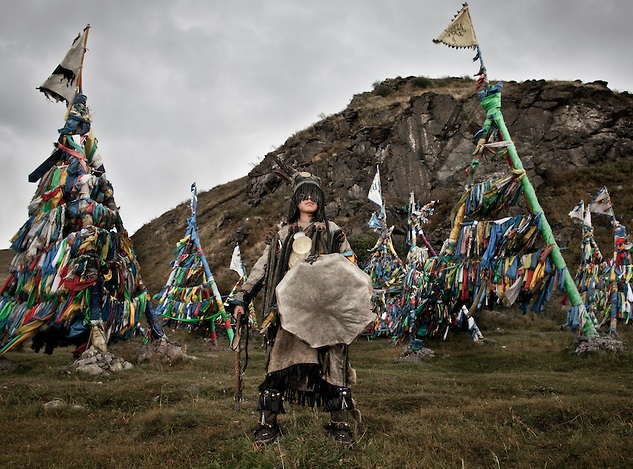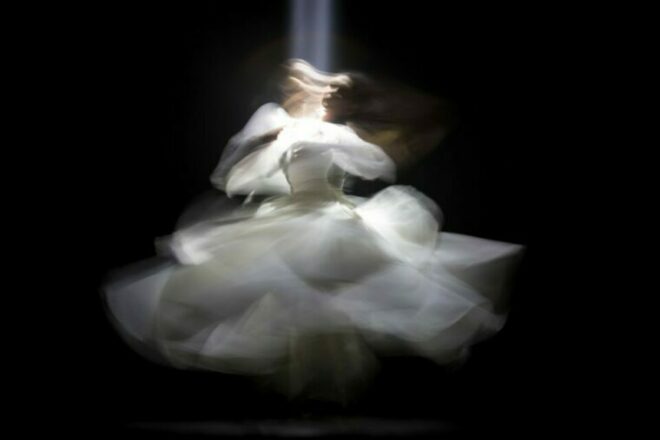Mongolian shamans consider that people and animals have not one, but three kinds of souls, an idea first talked about by B.Renchin in his aforementioned conversation of 1965:
Every person has three souls. Two of them are mortal, but the remaining one is immortal. According to Shamanism, they are the three spirits or deities of a man or woman, including the female spirit of flesh and blood, the male spirit of bones and lastly the Heaven spirits. After a person’s death, the mortal spirits will remain in the body for three years, for example the paternal spirits rests in the center socket of the pelvic bones. When this bone dies, the mortal spirits disappear and finally the immortal spirit will rise up. This is the main belief of the Mongolian Shamans in regard to the souls and spirits.
Afterward, in 1985, H.Buyanbat wrote, “According to Shamanist belief, every person has three kinds of souls: “Main”, which always remains with the physical body; “Ghostly”, which is always going away or traveling everywhere around the world; and “Body” souls. The third is the soul of the dead body”.
Moreover, according to Mr.Yonsog consideration of 1992: “Every human being has three souls known as of “Life”, “Mind” and “Future Birth”. Although there are few differences between the theabove-mentioned definitions, it is obvious that Mongolian Shamans have believed in the idea of three souls since ancient times. While, I do not know how H.Buyanbat and Mr.Yonsog conducted their research on Shamanism, but the late academician B.Renchin has researched Shamanism since 1927. Therefore, it seems that his explanation of souls in Mongolian Shamanism is both the clearest and best researched. Moreover, it coincides with Black Shamanist understanding concerning Souls and Spirits.
There were many notable shamans and their descendants, who still talked about the existence of the three souls (flesh, bone, and mind) in the 1950s and 1960s. According to them, the first, or flesh or blood soul, a maternal soul exists in all the body’s organs until the heart stops beating. As the heart dies, so does this soul. The bone soul is paternal and exists in all of the bones disappearing only after the death of the pelvic bones.
Thirdly, the mental or vital soul is introduced through the left ring finger to the fetus in its mother’s womb. After birth, the soul moves through marrow, brain, and pulses. When the body dies, the soul rests between the first (Atlas) and second (Axis) cervical vertebrae. Afterward, when the body has decomposed entirely, the soul rises up to the Darkness where it will remain for eternity. This is not the same as the explanation provided by H.Buyanbat and Mr.Yonsog. However, with the sole difference in the terminology for vital and Heaven souls, it is exactly the same as B.Renchin’s view of the Three Souls. Besides which, the Mongols would not leave a meatless pelvic bone in the home at overnight, because they believe that this socket holds the third or immortal soul of any person or animal. Moreover, if a pelvic bone is found on the road the whole or at least its socket should be broken. Similarly, there are some saying that a whole pelvic bone is the home of a devil. Nevertheless, some shamans consider that it is not a devil, but the soul of a dead man or animal. Sanje Zayran, a Red Huular who had lived in Hovsgol during the 19th century, his son Sambuu, nicknamed “Danar”, who died in 1954, his tutor Noorog Zayran and daughter Namjil shamaness (1914-1993) explained that there were no demons at all, but only soul or spirits. Devils were created by people to explain otherwise inexplicable phenomena.
Moreover, it was considered taboo to leave the skull of a goat or sheep, especially one with empty eye-sockets, in the home overnight. If it is impossible to take it out of the home, the eye-sockets should be plugged with animal hair or sheep wool according to the Halha, or the sockets were broken according to Zahchin custom. According to the Darhad, the skull-bone should release souls resting in the eye-sockets. However, a horse’s skull should be put on a mountaintop or cairn, because of the horse, known as “Horse-Erdene (treasure)”, is the most respected animal among the Mongols.
The burial of a guard dog has involved cutting off its tail to put under its head and put some butter or a large sheep’s tail in its mouth. In this way, people hope that the dog’s soul will be transformed. The Black Shamans hope that the soul will become a human soul, while Yellow Shamans hope that the dog will be reincarnated as a human. It is forbidden to give tea to someone in a chipped or cracked cup, for it is a cup no more, being only the soul and is, therefore, unsuitable for serving the living.
In regard to Buyanbat and Yonsog’s definition of three souls or more exactly their six variations: “Main”, “Ghostly”, “Dead body”, “Vital”, “Mind”, and “Future Birth” are incorrect. In this way, they have absolutely denied the two kinds of “Bone” and “Flesh” souls, which are the most important in Black Shamanism. I, therefore, doubt their conclusions and suspect that they may even have misunderstood Mongolian Shamanist belief in the Soul and the Spirit.
Moreover, concerning the Soul (Spirit), Indian yogis believe that we leave our bodies and that our spirit moves freely in the astral, or spirit dimension during sleep and also in some deep states of meditatilisetion or trance… The shamans or medicine people of many cultures have developed conscious control over many of these out-of-body experiences, and utilize such traveling to heal the sick and more through other planes of existence. They move beyond the physical plane of existence, and the limits of time where past, present and future events exist concurrently.
Everything has its own Soul
Apart from the three main tenets of Queen Earth, King Heaven, and the Deities of the Earth and Sky, the Soul is the fourth major concept of Mongolian Shamanism. According to Ch.Dalai, “Only Shamanism considers that the soul of a dead person continues to exist invisibly”. In this regard, H.Buyanbat wrote more specifically, “Shaman believers consider that every person has his/her own soul, which never dies”. Furthermore, Mr.Yonsog, considered, ‘Shamanism has a general belief that every kind of living creature and the natural thing has its own Soul and Guardian Spirit. So, all-natural events are affected by their influence, which is in turn resolved by their own Souls and Spirits”.
This makes it clear that Shamanism has a clearly thought out set of beliefs on the nature of the soul. However, Mr.Yonsog failed to make the necessary distinction between earth and water guardian spirits and the soul. Soul and spirit have different meanings in Mongolian Shamanism. For example, a living tree has its own soul; but forest as a whole and other natural resources have their own special spirit. If someone cuts down the tree then it dies, but if someone builds a wooden house then the house’s spirit will always exist because many trees were killed in order to build it. If people use trees wastefully or start wildfires, their spirits get angry and natural disasters such as floods and snowstorms will ensue. So, the main difference is that a soul belongs to a single entity such as a person, a plant or animal, white land and water spirits protect an area or group of entities.
In the Hunnu tombs of Noyon Uul and Evolga, human skeletons and coffins were found. Associated with these were horses, cattle, goat, sheep and camel bones, which were strung with rectangular pieces of wood. Ancient items and instruments such as bones from wild animals, needles, clothing, saddlebows, spades, and sickles were found there too. These finds suggest that the souls of the dead should remain associated with their possessions.
On the basis of some Chinese sources, G.Suhbaatar wrote that, during the burial ceremonies, a fat dog was dragged by a cord made from different types/ colors of fibers to the grave and finally all of the personal property of the deceased, including horses were burnt. In the period of ancient Toba, horses, clothing, and the cart bearing the departed were also burnt. Thus, Mongolian Shamanism considered that smoke lifted up the human soul along with the souls of his possessions to the darkness. Hence, when B.renchin was interviewed by the French journalists Noirou and Lanten in 1965, he said:
Shamanism has its own peculiarities. Mongolia social groups and classes believed that there are different kinds of Heavens or spirits. The soul rises up from a dead body. According to social rank, there are many soul. For example, the soul of a family master or tribe chieftain will remain as leader of all the souls of that family or tribe. Thus, souls exist for all animals, people and things. Therefore, it was a common occurence that when a person dies, his/her soul leaves the dead body. So people had customs to bury their dead with all his/her possessions, including horses, dogs, and even a man or woman, whom the deceased cherished.
However, Mr.Yonsog considered that “Soul” was for all things. For example, the soul was for a goat, sheep, horse, and fence. When the owner became richer, the souls began to scatter even toa lasso pole, its loop, and whip stick. According to Shamans, this protects all of them from any trouble or disaster”.
Thus, Mongolian Shaman believers thought that all kinds of creatures and lifeless items have their own souls, which, as guardian spirits or totems, protect them properly.
Source : Mongolian Shamanism by Purev Otgony



Comments are closed.